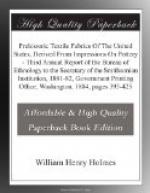This form of weaving is very common among the productions of the modern tribes of Western America. A very good example is shown in Fig. 87, which represents the border of a cape like garment made by the Clyoquot Indians, of Vancouver’s Island. It is woven, apparently, of the fiber of bark, both web and woof showing considerable diversity in the size of the cords. The border has been strengthened by sewing in a broad, thin fillet of rawhide.
[Illustration: Fig. 87.—Modern work, Vancouver’s Island.]
The beautiful mats of the northwest coast peoples, from California to Ounalaska, are often woven in this manner, the materials being bast, grass, or rushes.
The Lake Dwellers of Switzerland seem to have made a great many varieties of cloth of this type. I have reproduced four examples from the great work of Dr. Keller. Fig. 88 is copied from his Fig. 1, Plate CXXXV. It exhibits some variations from the type, double strips of bast being bound by a woof consisting of alternate strips of bast and cords. It is from Robenhausen.
[Illustration: Fig. 88.—Fabric
from the Lake Dwellings,
Switzerland.]
In Figs. 89 and 90 we have typical examples from the same locality. The woof series seems to consist of untwisted strands of bast or flax.
[Illustration: Figs. 89 and
90.—Fabrics from the Lake Dwellings,
Switzerland.]
Third group.
A third form of fabric is distinguished from the last by marked peculiarities in the combinations of the threads. The threads of the warp are arranged in pairs as in the last form described, but are twisted in such a way as to inclose two of the opposing series instead of one, each succeeding pair of warp threads taking up alternate pairs of the woof threads, as shown in the section, Fig. 91. This is a very interesting variety, and apparently one that would possess coherence and elasticity of a very high order.
[Illustration: Fig. 91.—Section.]
In Fig. 92 a simple scheme of plaiting or weaving this material is suggested. It will be seen to differ from the last chiefly in the way in which the woof is taken up by the warp.
[Illustration: Fig. 92.—Theoretical device for weaving third group.]
The ancient pottery of the Mississippi Valley furnishes many examples of this fabric. It is made of twisted cords and threads of sizes similar to those of the other work described, varying from the weight of ordinary spool cotton to that of heavy twine. The mesh is generally quite open.
In Fig. 93 we have a very well preserved example from Reelfoot Lake, Tennessee. It was obtained from a large fragment of coarse pottery. Other pieces are nearly twice as coarse, while some are much finer.
[Illustration: Fig. 93.—From the ancient pottery of Tennessee.]
Figs. 94 and 95 are finer specimens from the same locality.
[Illustration: Fig. 94. Fig.
95.
From the ancient pottery of Tennessee.]




